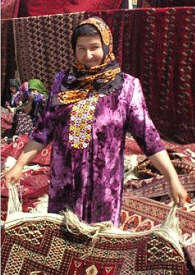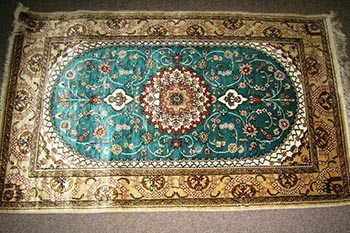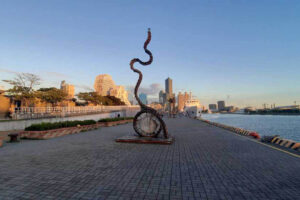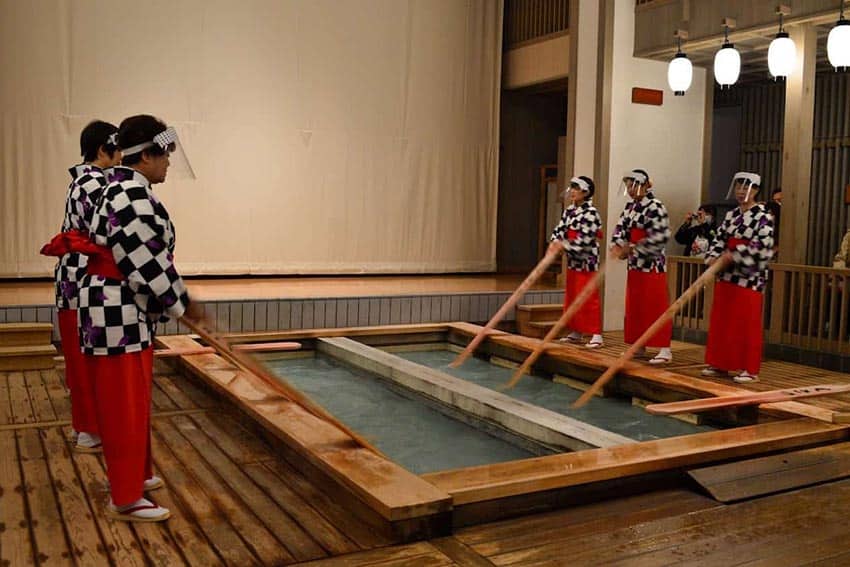By Jessica P. Hayden
Water is a Turkmen’s life, a horse is his wings, and a carpet is his soul. – Turkmen Proverb

As we drove down the tree-lined streets, we passed rows of tiny, one-floor houses that sat just yards away from the roadside.
I watched through the window as children scurried from one side of the road to the other, playing what appeared to be a game of tag. Women, dressed in brightly colored textiles, were gathered at the corner of one street, watching their children, gossiping.
We were headed to meet Gurban, a local carpet dealer, at his house in Ashgabat. My husband and I had flown to Turkmenistan for a long weekend.
Since moving to Central Asia, our friends had repeatedly advised us, “You must visit Ashgabat if you have the chance – it is like nothing you’ve ever experienced or are likely to experience again.”
Presidential Portraits
Part of this fascination with Turkmenistan comes from the unique political system and president who posts his portrait on every available wall space in the city. But the bigger allure for us was the chance to explore a land with ancient cultures and traditions that was once part of the Silk Road.
The Silk Road runs through Central Asia and was a major trading route connecting the West to the East for hundreds of years. In fact, it was the famed traveler, Marco Polo who was the first to mention Turkmen carpets in the 13th century.
While many regions along the Silk Road produce unique carpets, Turkmen rugs have become well known in the West, due to their high quality and beauty. The art of carpet weaving has been handed down from generation to generation and is central to the Turkmen culture. Each tribe has its own specific patterns and symbols which represent aspects of life which hold great importance.
Gurban and his family have been selling Turkmen carpets for years from their house and in the Tolkuchka bazaar (the Sunday market). As we entered a Spartan yet beautiful courtyard, a sea of carpets covered the concrete floor. The deep red and orange rugs gave such an aura of warmth it was hard to not feel immediately welcomed into their home.
Smiling and Flirting
Gurban invited us into his house for lunch and offered us a feast of chicken, plov (traditional Central Asian rice dish) fruit, fresh juices and tea. We sat on the floor, chatting with our new friends. The smaller children played hide and seek with us, peeking their heads in the door, smiling and flirting.
In the corner of the room a black and white television played a video-tape of a recent family wedding. The new bride now sat beside us, holding her new born child and pregnant with her second.
She held a piece of cloth from her headdress in her mouth, unable to speak in the presence of her mother-in-law, a Muslim tradition. We exchanged smiles and even without the benefit of words, she expressed pride in the wedding, her child, and her family.

After lunch, our carpet education began. My husband and I walked from carpet to carpet as Gurban helped to explain the significance and origin of each rug. Three hours later, our bellies full from our host’s generosity, we walked away with an armful of rugs and an amazing Turkmen experience.
The process of creating and selling Turkmen rugs is not simply commerce; it is part of a tradition that stretches back over the centuries. And as a visitor, learning about the Turkmen’s traditional art is one of the best ways to immerse yourself in the local culture.
Where to Learn More about Turkmen Culture and Rugs:
The Textile Museum – located in Washington, D.C., this museum is dedicated to furthering understanding of man’s achievements through textiles. They have an excellent education program (including travel) as well as an informative website. For more information visit
Turkmenistan Art
The Carpet Museum & Store – located in the center of Ashgabat, this museum is a great place to start in your textile and historical education.
Carpet Factories – if you are interested in seeing how carpets are woven, a visit to one of the “carpet factories” is a must. There are 15 across the country and the main factory in Ashgabat employs 200 people who produce the traditional “Bukhara” rugs by hand on looms – located on Kuragli Street.
The Tolkuchka Bazaar – open on Sundays and located just outside of Ashgabat. You will find the best prices on carpets here and you can easily spend an entire day wandering through the market, taking in the colors, smells, and local flavor.

Local Home Visits:
Gurban Yurtakov, Ashgabat: 327776 or 327834. Call to make an appointment.
Speaks Turkmen and Russian.
Kamoosh, Geok Depe (40 minutes outside of Ashgabat): 301562
Important Details:
Export taxes are assessed on all rugs that leave the country.
Take the Train: Rail Passes Around the World
 Jessica P. Hayden is a freelance writer who covers a range of issues including travel, politics, foreign affairs and law. Her work has appeared in Slate, Transitions Abroad, TravelMag, and numerous other publications. She also contributed to a book on investing for teens published by the Motley Fool. Visit her website at www.jesshayden.com.
Jessica P. Hayden is a freelance writer who covers a range of issues including travel, politics, foreign affairs and law. Her work has appeared in Slate, Transitions Abroad, TravelMag, and numerous other publications. She also contributed to a book on investing for teens published by the Motley Fool. Visit her website at www.jesshayden.com.
- These 9 U.S. National Parks Require Reservations in 2024 - April 17, 2024
- Take a Hike in Olympic National Park - April 17, 2024
- The Wild Mississippi: 2340 Miles Across Ten States - April 8, 2024





